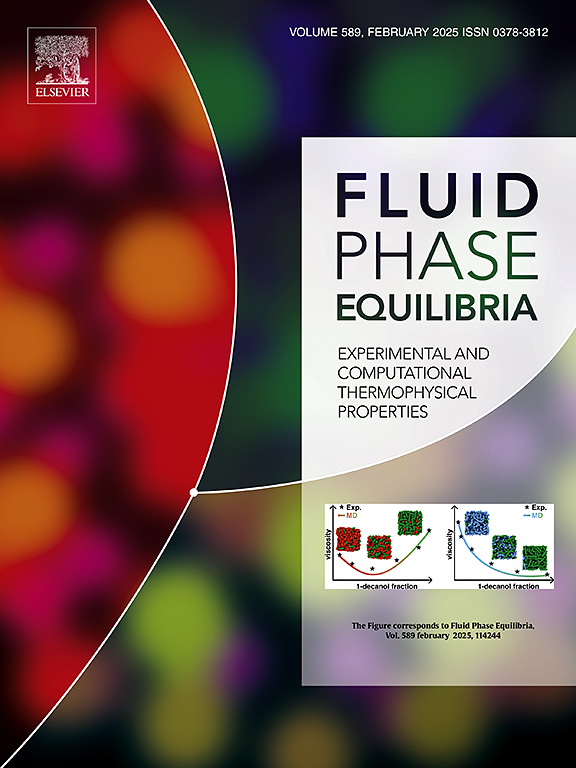离子活度系数的贡献:状态方程与分子模拟的回顾与比较
IF 2.8
3区 工程技术
Q3 CHEMISTRY, PHYSICAL
引用次数: 0
摘要
电解质溶液的高级状态方程(e-EoS)由许多来自不同分子间力的贡献组成,例如斥力、色散、氢键、离子之间的相互作用、离子溶剂化和其他可能的作用。很难建立一个先验,即各种贡献的正确平衡,不同的参数估计策略可能导致具有完全不同趋势的模型的相似性能。本工作的第一部分是对现有电解质模型(活度系数模型和e-EoS模型)所表现出的力平衡的文献综述。在本工作的第二部分,分析了基于Saravi和Panagiotopoulos最近研究的分子模拟(MS)计算的活度系数和各项的贡献,并与它们在25°C和1 bar下的e-EoS对应物进行了比较。我们从文献中考虑了三个e-EoS,即eSAFT-VR Mie, ePPC-SAFT和e-CPA。文献中已经提出了使用所谓的隐式和显式模拟的质谱研究,但这里只考虑后者,因为水被视为分子,因为这些更接近实验数据。虽然MS贡献与e-EoS条款之间的对应关系尚未完全建立,但我们得到了一些与e-EoS性能相关的结论。本文章由计算机程序翻译,如有差异,请以英文原文为准。
Contributions to ionic activity coefficients: A review and comparison of equations of state with molecular simulations
Advanced Equations of State for electrolyte solutions (e-EoS) consist of many contributions stemming from different intermolecular forces, e.g. repulsion, dispersion, hydrogen bonding, as well as ionic interactions between ions, ion solvation and possibly others. It is difficult to establish a priori which is the correct balance of the various contributions, and different parameter estimation strategies may result in similar performance of models having entirely different trends with respect to the contribution of the various terms. The first part of this work is a literature review on the balance of forces exhibited by existing electrolyte models, both activity coefficient models and e-EoS. In the second part of this work, the activity coefficients and the contributions of the various terms calculated by molecular simulation (MS) based on the recent studies by Saravi and Panagiotopoulos are analyzed and compared to their e-EoS counterparts at 25 °C and 1 bar. We have considered three e-EoS from literature, namely the eSAFT-VR Mie, ePPC-SAFT and e-CPA. MS studies have been presented in literature both using the so-called implicit and explicit simulations, but only the latter are considered here where water is treated as a molecule, as these are in closer agreement to experimental data. Although correspondence between MS contributions and e-EoS terms is not fully established, some conclusions related to the performance of e-EoS are obtained.
求助全文
通过发布文献求助,成功后即可免费获取论文全文。
去求助
来源期刊

Fluid Phase Equilibria
工程技术-工程:化工
CiteScore
5.30
自引率
15.40%
发文量
223
审稿时长
53 days
期刊介绍:
Fluid Phase Equilibria publishes high-quality papers dealing with experimental, theoretical, and applied research related to equilibrium and transport properties of fluids, solids, and interfaces. Subjects of interest include physical/phase and chemical equilibria; equilibrium and nonequilibrium thermophysical properties; fundamental thermodynamic relations; and stability. The systems central to the journal include pure substances and mixtures of organic and inorganic materials, including polymers, biochemicals, and surfactants with sufficient characterization of composition and purity for the results to be reproduced. Alloys are of interest only when thermodynamic studies are included, purely material studies will not be considered. In all cases, authors are expected to provide physical or chemical interpretations of the results.
Experimental research can include measurements under all conditions of temperature, pressure, and composition, including critical and supercritical. Measurements are to be associated with systems and conditions of fundamental or applied interest, and may not be only a collection of routine data, such as physical property or solubility measurements at limited pressures and temperatures close to ambient, or surfactant studies focussed strictly on micellisation or micelle structure. Papers reporting common data must be accompanied by new physical insights and/or contemporary or new theory or techniques.
 求助内容:
求助内容: 应助结果提醒方式:
应助结果提醒方式:


